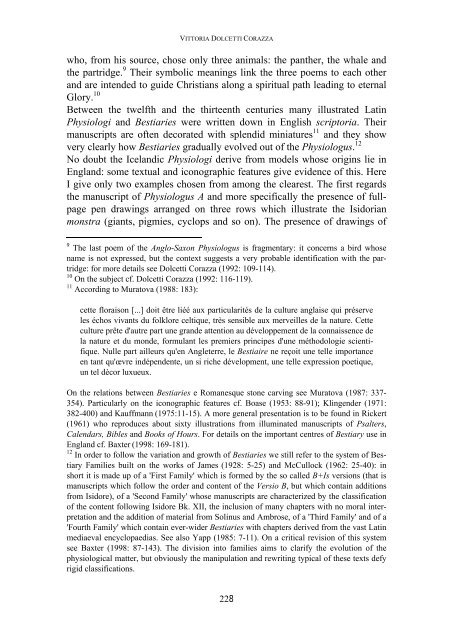Crossing paths in the Middle Ages: the Physiologus in Iceland - Lear
Crossing paths in the Middle Ages: the Physiologus in Iceland - Lear
Crossing paths in the Middle Ages: the Physiologus in Iceland - Lear
Create successful ePaper yourself
Turn your PDF publications into a flip-book with our unique Google optimized e-Paper software.
VITTORIA DOLCETTI CORAZZA<br />
who, from his source, chose only three animals: <strong>the</strong> pan<strong>the</strong>r, <strong>the</strong> whale and<br />
<strong>the</strong> partridge. 9 Their symbolic mean<strong>in</strong>gs l<strong>in</strong>k <strong>the</strong> three poems to each o<strong>the</strong>r<br />
and are <strong>in</strong>tended to guide Christians along a spiritual path lead<strong>in</strong>g to eternal<br />
Glory. 10<br />
Between <strong>the</strong> twelfth and <strong>the</strong> thirteenth centuries many illustrated Lat<strong>in</strong><br />
Physiologi and Bestiaries were written down <strong>in</strong> English scriptoria. Their<br />
manuscripts are often decorated with splendid m<strong>in</strong>iatures 11 and <strong>the</strong>y show<br />
very clearly how Bestiaries gradually evolved out of <strong>the</strong> <strong>Physiologus</strong>. 12<br />
No doubt <strong>the</strong> <strong>Iceland</strong>ic Physiologi derive from models whose orig<strong>in</strong>s lie <strong>in</strong><br />
England: some textual and iconographic features give evidence of this. Here<br />
I give only two examples chosen from among <strong>the</strong> clearest. The first regards<br />
<strong>the</strong> manuscript of <strong>Physiologus</strong> A and more specifically <strong>the</strong> presence of fullpage<br />
pen draw<strong>in</strong>gs arranged on three rows which illustrate <strong>the</strong> Isidorian<br />
monstra (giants, pigmies, cyclops and so on). The presence of draw<strong>in</strong>gs of<br />
9<br />
The last poem of <strong>the</strong> Anglo-Saxon <strong>Physiologus</strong> is fragmentary: it concerns a bird whose<br />
name is not expressed, but <strong>the</strong> context suggests a very probable identification with <strong>the</strong> partridge:<br />
for more details see Dolcetti Corazza (1992: 109-114).<br />
10<br />
On <strong>the</strong> subject cf. Dolcetti Corazza (1992: 116-119).<br />
11<br />
Accord<strong>in</strong>g to Muratova (1988: 183):<br />
cette floraison [...] doit être liéé aux particularités de la culture anglaise qui préserve<br />
les échos vivants du folklore celtique, très sensible aux merveilles de la nature. Cette<br />
culture prête d'autre part une grande attention au développement de la connaissence de<br />
la nature et du monde, formulant les premiers pr<strong>in</strong>cipes d'une méthodologie scientifique.<br />
Nulle part ailleurs qu'en Angleterre, le Bestiaire ne reçoit une telle importance<br />
en tant qu'œvre <strong>in</strong>dépendente, un si riche dévelopment, une telle expression poetique,<br />
un tel dècor luxueux.<br />
On <strong>the</strong> relations between Bestiaries e Romanesque stone carv<strong>in</strong>g see Muratova (1987: 337-<br />
354). Particularly on <strong>the</strong> iconographic features cf. Boase (1953: 88-91); Kl<strong>in</strong>gender (1971:<br />
382-400) and Kauffmann (1975:11-15). A more general presentation is to be found <strong>in</strong> Rickert<br />
(1961) who reproduces about sixty illustrations from illum<strong>in</strong>ated manuscripts of Psalters,<br />
Calendars, Bibles and Books of Hours. For details on <strong>the</strong> important centres of Bestiary use <strong>in</strong><br />
England cf. Baxter (1998: 169-181).<br />
12 In order to follow <strong>the</strong> variation and growth of Bestiaries we still refer to <strong>the</strong> system of Bestiary<br />
Families built on <strong>the</strong> works of James (1928: 5-25) and McCullock (1962: 25-40): <strong>in</strong><br />
short it is made up of a 'First Family' which is formed by <strong>the</strong> so called B+Is versions (that is<br />
manuscripts which follow <strong>the</strong> order and content of <strong>the</strong> Versio B, but which conta<strong>in</strong> additions<br />
from Isidore), of a 'Second Family' whose manuscripts are characterized by <strong>the</strong> classification<br />
of <strong>the</strong> content follow<strong>in</strong>g Isidore Bk. XII, <strong>the</strong> <strong>in</strong>clusion of many chapters with no moral <strong>in</strong>terpretation<br />
and <strong>the</strong> addition of material from Sol<strong>in</strong>us and Ambrose, of a 'Third Family' and of a<br />
'Fourth Family' which conta<strong>in</strong> ever-wider Bestiaries with chapters derived from <strong>the</strong> vast Lat<strong>in</strong><br />
mediaeval encyclopaedias. See also Yapp (1985: 7-11). On a critical revision of this system<br />
see Baxter (1998: 87-143). The division <strong>in</strong>to families aims to clarify <strong>the</strong> evolution of <strong>the</strong><br />
physiological matter, but obviously <strong>the</strong> manipulation and rewrit<strong>in</strong>g typical of <strong>the</strong>se texts defy<br />
rigid classifications.<br />
228

















